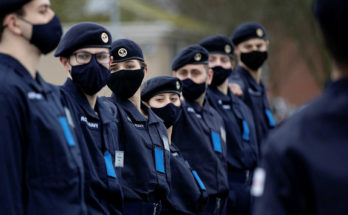
Talk: Angela Owen OBE of Women in Defense UK, in conversation with Maj. Gen. Tom Bewick OBE, GOC Army Recruiting & Initial Training
Interviewer: Angela Owen, Founder – Women in Defence UK
Guest: Ma. Gen. Tom Bewick OBE, General Officer Commanding, Army Recruiting and Initial Training Command (ARITC) – British Army
Day three of DSEI began with a discussion regarding a critical question for the British armed forces, “How does the Army increase recruitment of women and minorities?” The question is a strategic one and at the forefront of the Ministry of Defence’s priorities. In framing the talk, Angela Owen, a 30-year British Army veteran, pointed to the MoD’s 2023 Defence Command Paper (DCP23) that stresses people as the MoD’s most important asset and sets a goal to diversify the workforce by focusing on the specific inclusion of women and ethnic minorities.
Major General Bewick, tasked with the Army’s regular and reserve recruiting and training, acknowledged the importance of the endeavor and the current challenges women face, including greater social pressures than men and gender norms that hinder women from joining the military. Though challenges abound, Bewick began by citing some positive trends: there is no gender imbalance in basic training completion rates among men and women, and the Army is retaining more women than men in the long term.
But not all is well, as the British Army now faces obstacles similar to those confronting almost every Western military force seeking to strengthen through diversity. Bewick noted the overarching problem is two-fold. The armed forces are struggling to recruit in both overall numbers and targeted demographics. If the numbers of eligible and interested recruits are down across the board, then building a diverse Army is even more difficult.
Narrowing the issue down to women in the Army, Bewick said the key is ensuring women feel they are wanted in the service. While women represent over 20 percent of applicants to join and/or register for the Army, they are not converting from the recruitment phase into entering basic training at a similar rate. In other words, there is a discrepancy from the initial phase to the full entry phase. Bewick believes getting women to the basic training start line is an issue, and that in response the Army must convince them that it wants their service. A new recruiting campaign titled “You belong here” aims to do just that.
Owen and Bewick agreed that obtaining “critical mass” in individual Army units would help move the service toward its goal – that means a point where social attitudes and momentum change, barriers fall, and women and minorities feel that they belong in the group. Owen referenced successful efforts to include women in other parts of the U.K. government, particularly MI5, where recruiting of women is up 50 percent. The security agency practices regular call-ups with women, features enticing offers, and recruits women based on aptitude focusing on skills training later in the pipeline.
Owen pressed questions on lateral entry: leaving the service and returning at a later time, maternity and paternity leave policies, and gender-based nomenclature for military specialties. Bewick responded by stating the Army’s internal discussion of these topics is live and active and that he was “fully supportive of removing any barriers to service.”
More attractive policies are part of the equation, but the foundational issue at stake is clear. A sense of belonging and equality is crucial. The U.S. military has struggled to equitably include females and minorities in certain teams for decades. In at least some areas of the U.S. armed forces, the institution and individual units are failing to foster an accepting environment. A recent internal U.S. Army Special Operations Command report found women in the special operations community face “blatant sexism,” do not report sexual harassment due to fear of retaliation, and must wear ill-fitting equipment.
There is no easy or short-term fix for changing norms and overturning discriminatory patterns. Even with concerted leadership efforts, it can take generations to enact change. Nonetheless, it’s difficult to imagine the success of strategies and practices for recruiting women and minorities with these problems still at play in the armed forces of Western nations.
When asked where he expects recruitment to be in the future, Major General Bewick placed a goal of female recruitment above 20 percent by 2030. In particular, he said the Army must focus on diversifying not only personnel but also occupational positions including engineering and digital, which will drive better recruitment for women and minorities. He added that to build a better and stronger force, the British Army must get both “volume and shape” right.
A former naval officer and helicopter pilot, Jon covers a range of Forecast International reports and products, drawing on his 10-year background in military aviation, operations, and education. His previous military assignments include multiple overseas deployments supporting operations in the Arabian Gulf, NATO exercises, and humanitarian missions. Jon’s work is also influenced by his time as a former Presidential Management Fellow and international trade specialist at the Department of Commerce.
Before joining Forecast International, Jon also served as an NROTC instructor and Adjunct Assistant Professor at the University of Texas, where he taught undergraduate courses on naval history, navigation, defense organization, and naval operations and warfare. A lifelong reader and learner, his academic and professional interests include aviation, political and military history, national defense and security, and foreign area studies.




